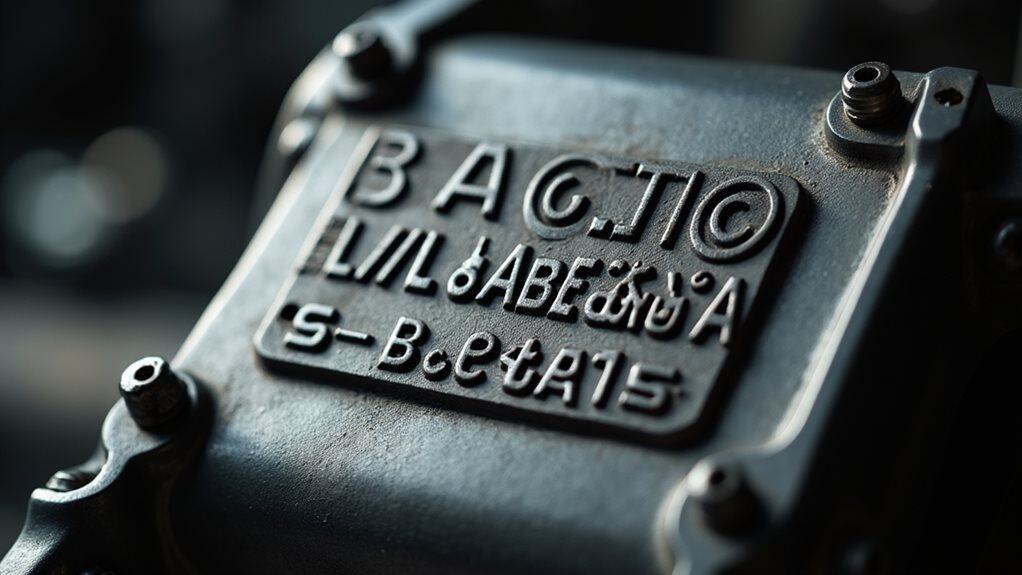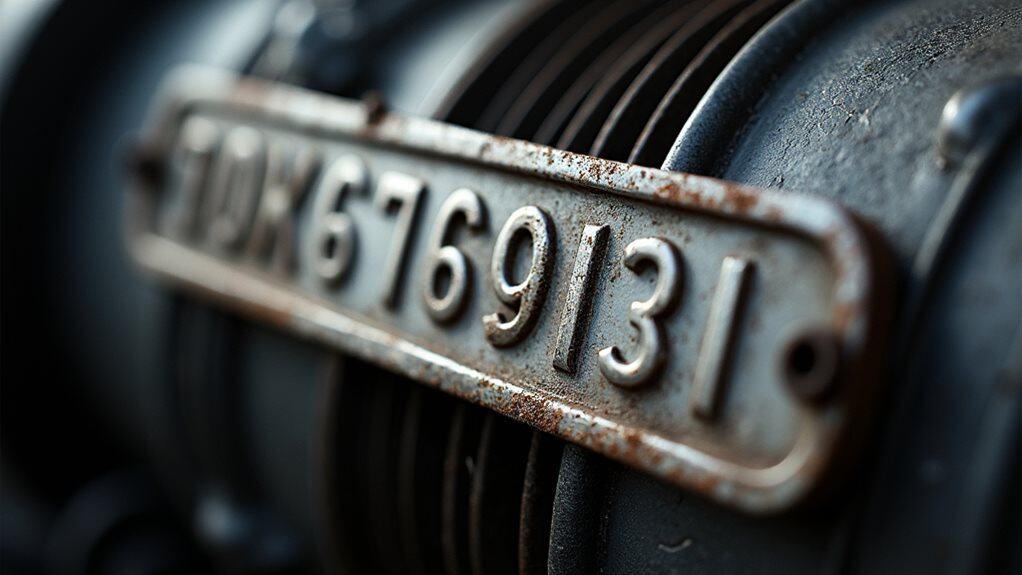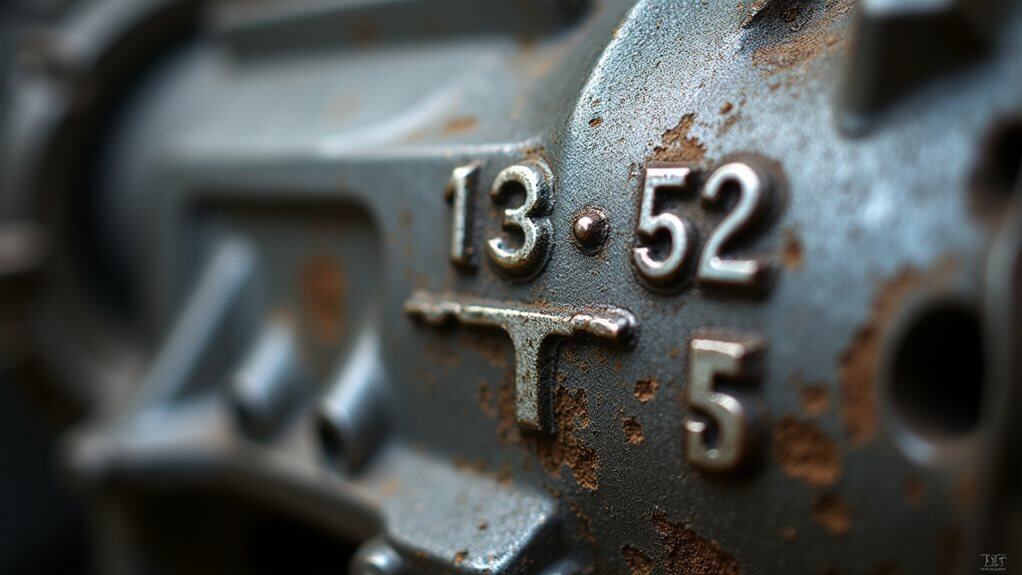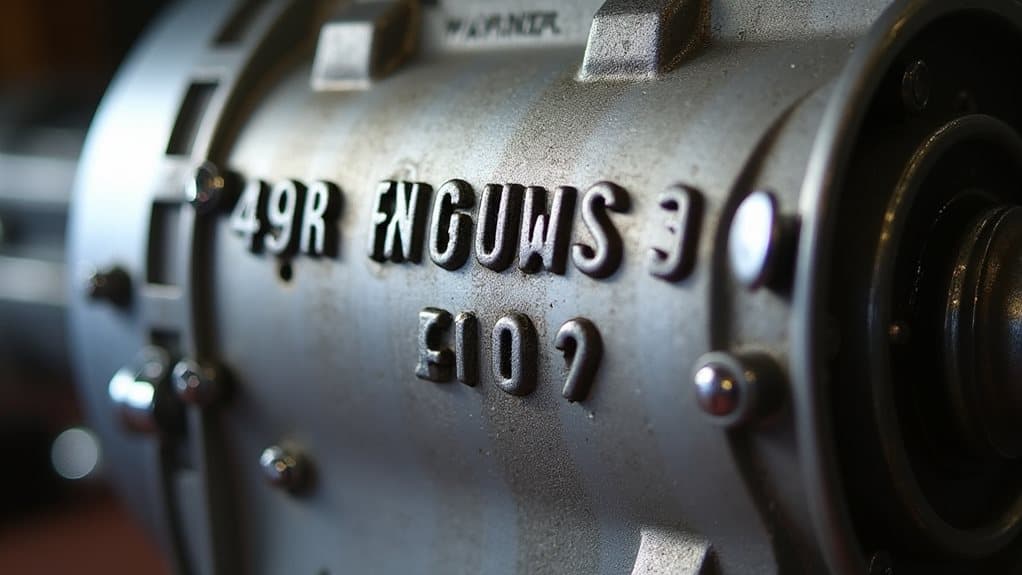You’ll find Borg-Warner transmission identification numbers on metal ID tags attached to the transmission case, typically displaying a seven-digit “1352-XXX” format where the first four digits identify the transmission family and the last three reveal your specific model variant and gear ratios. When ID tags are missing or damaged, you can use ten-digit casting numbers stamped directly into the case, though these require cross-referencing with documented charts for accurate identification. Understanding these numbering systems helps you distinguish between World Class and Non-World Class T-5 models, which handle different torque capacities and use distinct internal components. Continue exploring to master the complete identification process.
Quick Tips
- ID tags are located on the tail housing area, under the second bolt from the top on the left side of the transmission case.
- The 7-digit ID tag follows format “1352-XXX” where “1352” identifies the transmission family and last three digits indicate specific model variant.
- World Class models handle 300 lb-ft torque with needle bearings while Non-World Class models handle 265 lb-ft with journal bearings.
- When ID tags are missing, use 10-digit casting numbers stamped directly into the case for identification through documented reference charts.
- Avoid confusing 10-digit casting numbers molded into the case with 7-digit ID tag codes on separate metal plates.
Understanding Borg-Warner T-5 ID Tag Location and Format

When you’re trying to identify a Borg-Warner T-5 transmission, you’ll first need to locate the ID tag, which is bolted to the tail housing area of the transmission case.
You’ll typically find it under the second bolt from the top on the left side. A stripped bolt can complicate the process of removing the ID tag, making it crucial to handle the bolts carefully to avoid stripped bolt issues. The metal tag displays a “1352-xxx” or “13-52-xxx-xxx” number format with seven to ten stamped digits. Ford utilized aluminum tags, while GM used steel tags that are prone to rusting.
Differentiating World Class Vs Non-World Class T-5 Transmissions
Although both variants share the T-5 designation, World Class (WC) and Non-World Class (NWC) transmissions differ markedly in their internal construction, performance capabilities, and maintenance requirements. You’ll find WC models use needle bearings and fiber-lined synchronizers, while NWC units employ journal bearings and brass synchronizers. Additionally, proper maintenance is crucial to prevent issues similar to those experienced with the Mazda CX-5, such as unexpected shutdowns and performance degradation. WC transmissions handle 300 lb-ft torque versus NWC’s 265 lb-ft rating. The T-5 follows a specific part number format of 1352-000-xxx, where the final three digits indicate the application-specific variant.
Decoding the 7-Digit ID Tag Number System

When you examine a Borg Warner T-5 transmission’s ID tag, you’ll find a systematic 7-digit number that follows the format “1352-XXX,” where the consistent prefix “1352” identifies the transmission family and the final three digits reveal the specific model variant.
The last three digits serve as your key to determining whether you’re dealing with a World Class or Non-World Class transmission, as each generation uses distinct numerical codes that correspond to different gear ratios and vehicle applications.
Understanding this numbering system allows you to decode critical information about your transmission’s internal specifications, original equipment manufacturer, and intended vehicle fitment simply by reading the metal tag bolted to the tailhousing. Additionally, knowing about transmission fluid issues can help in troubleshooting performance problems related to your Borg Warner transmission.
ID Tag Format Structure
The Borg Warner transmission ID tag displays a distinctive 7-digit number system that serves as the primary identification method for determining your transmission’s exact specifications and original vehicle application.
You’ll typically find this number formatted in three segments separated by dashes, such as “13-52-065.” Each segment represents specific transmission family, model designation, and variation codes respectively.
World Class Identification Codes
Once you’ve located the 7-digit ID tag on your transmission’s tail housing, you’ll need to decode its specific number sequence to determine whether you’re dealing with a World Class or Non-World Class Borg Warner T-5.
All tags begin with “1352,” followed by model-specific digits like “065-908” for Ford WC units from 1985-1991.
Application-Specific Number Meanings
Understanding what those specific digits mean after the initial “1352” prefix requires breaking down the complete 7-digit structure systematically.
The next three digits indicate casting or application codes that identify your transmission’s variant and original vehicle application.
The final digits specify production details like input shaft design and case variations, determining vehicle compatibility and proper fitment.
Using Casting Numbers When ID Tags Are Missing

When ID tags go missing from Borg Warner transmissions, casting numbers become your primary identification tool, though they’ll present unique challenges that require careful interpretation.
These 10-digit numbers, stamped directly into the case, can mislead you since identical casting numbers appear across different makes and models.
You’ll need cross-referencing with documented charts and supplementary details. Additionally, understanding common engine issues related to the vehicle can help narrow down the specific model and its requirements for repairs or replacements.
Identifying Borg-Warner Automatic Transmission Model Numbers
Borg-Warner automatic transmission model numbers follow a distinctive M-xx format that serves as your roadmap to understanding these complex units.
Models like M11, M11B, M12, M35, M36, and M37 represent specific transmission series and variations. The first digit indicates the transmission generation, while the second digit shows improvements within that series, affecting torque capacity and design features.
Physical Characteristics and Visual Identification Methods

Since model numbers alone don’t always tell the complete story, you’ll need to examine the physical characteristics of your Borg-Warner transmission to achieve accurate identification.
Look for green-and-white metal ID tags bolted to the tail housing, which display seven-digit stamped numbers. These tags provide more reliable identification than casting numbers, which are longer and often recycled across different models.
Avoiding Common Identification Mistakes and Misinterpretation
When identifying Borg Warner transmissions, you’ll often encounter confusion between casting numbers and actual ID tag numbers, which can lead to serious misidentification problems.
Casting numbers typically contain 10 digits and appear molded directly into the transmission case, while genuine ID tags feature 7-digit codes on separate metal plates or stamped housings.
This distinction becomes critical when determining whether you’re dealing with a world-class transmission variant, since casting numbers alone can’t provide accurate model identification and may appear identical across completely different transmission types.
Casting Vs Tag Numbers
Although both casting and tag numbers serve identification purposes, confusing these two distinct marking systems represents one of the most common pitfalls in transmission identification.
Casting numbers are permanently molded into the case with 10+ digits, while tag numbers appear on removable metal plates with typically 7 digits.
You’ll find casting numbers generic to case designs, but tag numbers provide specific application details.
World Class Misidentification
While Borg Warner transmissions share many visual similarities, distinguishing between World Class and Non-World Class T5 models creates significant identification challenges that can lead to costly mistakes.
You’ll encounter Ford and GM T5s sharing identical casting numbers but differing in World Class designation. This confusion stems from production overlaps during the mid-1980s changeover period when improved materials and synchronizers were introduced.
Wrapping Up
You’ve now acquired expertise in the essential techniques for identifying Borg-Warner transmissions through ID tags, casting numbers, and physical characteristics. Remember to check multiple identification points when possible, as single markers can mislead you. Always verify World Class versus Non-World Class T-5 distinctions carefully, since they’re not interchangeable. With practice, you’ll quickly recognize these transmissions and avoid costly mistakes. Keep reference materials handy until you’ve memorized the common number patterns and visual differences.

